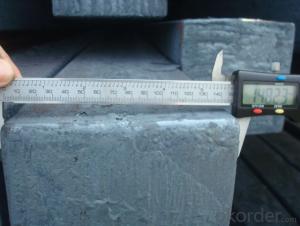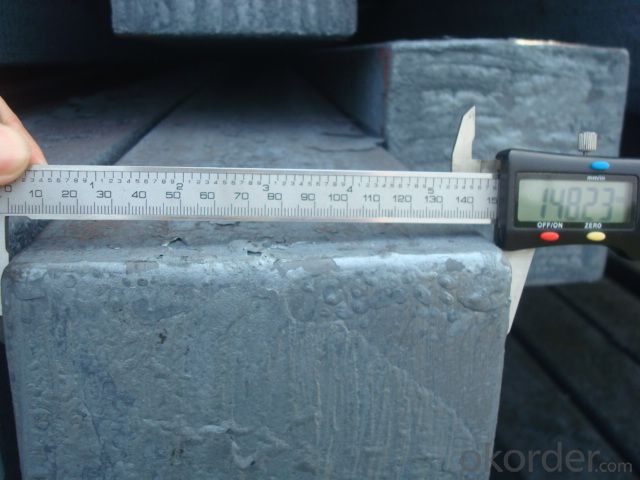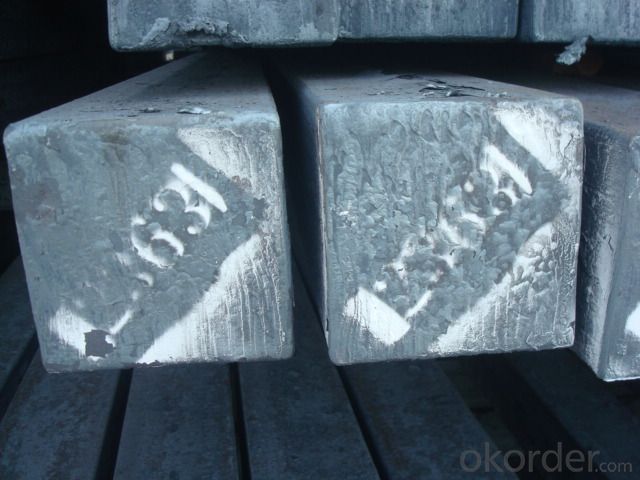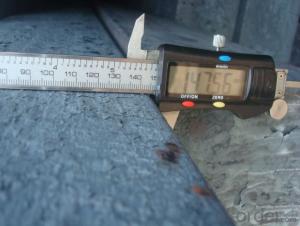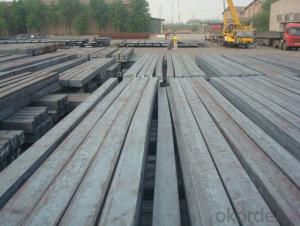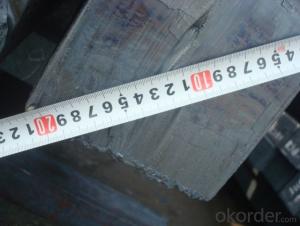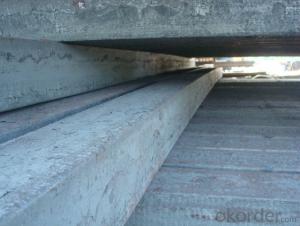Steel Billet Manufactured By Blasting Furnace
- Loading Port:
- Tianjin
- Payment Terms:
- TT OR LC
- Min Order Qty:
- 1000 m.t.
- Supply Capability:
- 100000 m.t./month
OKorder Service Pledge
OKorder Financial Service
You Might Also Like
Steel Billet Manufactured By Blasting Furnace
1.Structure of Steel Billet Manufactured By Blasting Furnace
Steel Billet Manufactured By Blasting Furnace is the raw material of all kinds of steel mill. Billet section of square, round, flat, rectangular and abnormity, etc Several, mainly related to shape of rolled products. Simple rolled section steel, choose cross section of square billet or rectangular billet. rolling The sector products such as flat steel, Angle steel, select the rectangular billet or slab. Had better profiled billet when production beams, channels, and in rolling process Lines and improve the yield. The raw material of round billet is the production of seamless tube.
2.Main Features of Steel Billet Manufactured By Blasting Furnace.
The classification of the billet Mainly from the shape is divided into two kinds: Slab: cross section width and height of the ratio of the larger, mainly used for rolling plate. Billet: equal cross section width and height, or a huge difference, mainly used for rolling steel, wire rod.
Billet material standard The thickness range: 150-240 - mm + / - 5 mm The width of the range: 880-1530 - mm + / - 20 mm Length range: 3700-10000 - mm + / - 500 - mm Cross-sectional size: 64 * 64 ; 82 * 82 ; 98 * 98 ; 124 * 124 ; 120 * 150 ; 152 * 164 ; 152 * 170 mm Length: 9000 mm The section of tolerance: billet: 1.0 + / - 2.0-1.0 + / - 1.0 mm The slab width: + / - 2.0 MM ; Thickness: + / - 3.0 MM
The length of tolerance: + / - 200 - mm The section diagonal tolerance: 3.5 8.0 MM Billet section size protrusions requirements: < 1242 mm Don't allow; = 1242 mm , > < = 2 mm to 1242 mm , The < = 3 mm beheaded ( shear ) Extension deformation: < 1242 mm Billet: no control; The slab: < = 15 mm Surface tilt: no more than in the cross section of the billet 0.1
3. Steel Billet Manufactured By Blasting Furnace Images
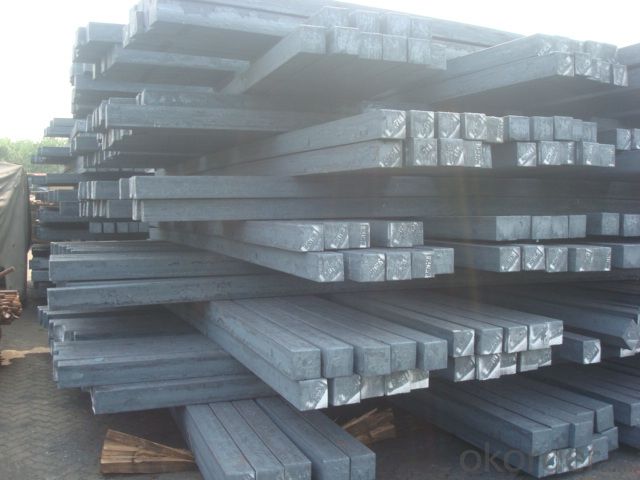
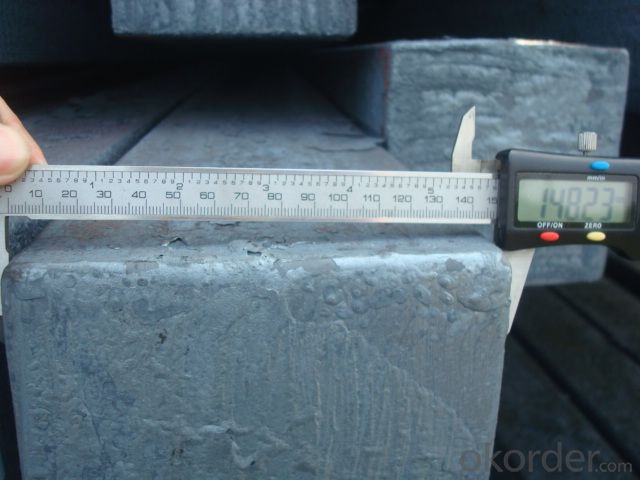
4. Steel Billet Manufactured By Blasting Furnace Specification
Steel Billet Manufactured By Blasting Furnace rolled steel, after processing can be used for mechanical parts, forging parts, processing all kinds of steel, steel Q345B channel steel, wire rod is the role of the billet. Steel billet is used in the production of semi-finished products, generally cannot be used directly for the society. Steel billets and steel are strictly divided into standard, cannot decide to whether the business enterprise of the final product, and according to unified standards to perform the whole society. Typically, billet and the steel is relatively easy to distinguish, but for some steel billet, and have the same specification and same steel purposes (such as rolling tube billet), whether can be used for other industries, whether through steel processing process, whether through a finished product rolling mill processing to distinguish
Material standard The editor Range of thickness: 150-240 - mm + / - 5 mm width range: 880-1530 - mm + / - 20 mm Length: 3700-10000 - mm + / - 500 - mm Cross-sectional size: 64 * 64; 82 * 82; 98 * 98; 124 * 124; 120 * 150; 152 * 164; 152 * 170 mm Length: 9000 mm Section of tolerance: billet: 1.0 + / - 2.0-1.0 + / - 1.0 mm slab: width: + / - 2.0 mm thickness: + / - 3.0 mm The length tolerance: + / - 200 mm Section diagonal tolerance: 3.5-8.0 MM Billet section size protrusions requirements: < 1242 mm, do not allow; > = 1242 mm, < = 2 mm 1242 mm, < = 3 mm Beheading (shear) extension deformation: < 1242 mm billet: no control; The slab: < = 15 mm Surface tilt: no more than billet section 0.1 Bending: every 1 m length is not more than 10 mm The distortion: length < = 5 m, < = 11. ; The length of the < = 7.5 M, < = 5. Material % 3 sp/PS chemical composition: C Mn Si S P
5.FAQ of Steel Billet Manufactured By Blasting Furnace
We have organized several common questions for our clients,may help you sincerely:
①How about your company?
A world class manufacturer & supplier of castings forging in carbon steel and alloy steel,is one of the large-scale professional investment casting production bases in China,consisting of both casting foundry forging and machining factory. Annually more than 8000 tons Precision casting and forging parts are exported to markets in Europe,America and Japan. OEM casting and forging service available according to customer’s requirements.
②How to guarantee the quality of the products?
We have established the international advanced quality management system,every link from raw material to final product we have strict quality test;We resolutely put an end to unqualified products flowing into the market. At the same time, we will provide necessary follow-up service assurance.
③How is the packaging and delivery?
Loose by Vessel and the delivery term is based on the the quantity and our factory’s schedule then.
- Q: How are steel billets used in the manufacturing of structural steel?
- Steel billets are a crucial raw material in the manufacturing of structural steel. These billets, which are essentially semi-finished steel products, are typically produced through a process called continuous casting, where molten steel is solidified into a rectangular shape. Once the steel billets are formed, they are further processed in steel mills to create various structural steel products such as beams, columns, angles, and channels. The billets are heated and then passed through a series of rolling mills, where they undergo intense pressure and shaping to achieve the desired dimensions and profiles. During the rolling process, the steel billets are elongated and transformed into long, slender shapes. This is achieved by repeatedly passing the billets through a set of rollers, which gradually reduce their cross-sectional area. The rolling mills can be configured differently to produce different types of structural steel products, catering to specific construction requirements. After the rolling process, the structural steel products are further subjected to various finishing processes such as cooling, cutting, straightening, and surface treatment. These processes ensure that the final product meets the required specifications, including dimensional accuracy, surface quality, and mechanical properties. The use of steel billets in the manufacturing of structural steel offers several advantages. Firstly, the semi-finished nature of billets allows for flexibility in customization, enabling the production of steel products with different sizes, shapes, and profiles. Additionally, the continuous casting process used to produce billets ensures a more consistent and uniform material quality, reducing the risk of defects or inconsistencies in the final product. Overall, steel billets play a vital role in the manufacturing of structural steel by providing a reliable and versatile raw material. Their transformation through rolling and other processes allows for the production of high-quality, durable, and structurally sound steel products that are widely used in construction, infrastructure, and industrial applications.
- Q: How are steel billets used in the manufacturing of tooling?
- Tooling manufacturing relies heavily on steel billets as a vital element. Tooling involves the creation and design of tools utilized across different industries for the purpose of cutting, shaping, or forming materials. Steel billets are semi-finished goods formed by casting molten steel and subsequently hot rolling them into diverse sizes and shapes. In tooling manufacturing, steel billets serve as the fundamental material from which tools are shaped. Typically, these billets are crafted from high-quality steel alloys known for their exceptional strength, durability, and resistance to wear. The presence of these traits is crucial in tooling applications as they guarantee the longevity and performance of the tools. Once steel billets are acquired, they undergo a series of processes to transform them into tooling components. The initial step entails heating the billets to a specific temperature, often exceeding the recrystallization temperature. This elevation in temperature renders the steel more malleable and easier to shape. This process is referred to as hot working. Subsequent to heating, the steel billets are shaped into the desired form using a variety of techniques including forging, extrusion, or rolling. These methods enable the steel to be molded into intricate shapes such as dies or molds, which are commonly employed in tooling applications. The shaping process ensures that the tooling components possess the requisite dimensions, surface finish, and structural integrity to effectively fulfill their intended purpose. Once the tooling components are shaped, they may undergo additional heat treatments to further enhance their mechanical properties. Processes such as tempering, annealing, or hardening are frequently employed to modify the steel's hardness, toughness, and resistance to wear. These treatments augment the lifespan of the tooling and enhance its performance in demanding manufacturing environments. In summary, steel billets play a vital role in tooling manufacturing by serving as the initial material for shaping tooling components. The utilization of high-quality steel in billets provides the necessary strength and durability required for tooling applications. Through the process of shaping, heat treating, and finishing these billets, manufacturers are able to create tooling that meets the specific requirements of diverse industries, enabling efficient and precise cutting, shaping, and forming of materials.
- Q: How are steel billets used in the production of aerospace structures?
- Steel billets are used in the production of aerospace structures as they are melted and cast into various shapes to create critical components such as beams, brackets, and fittings. These billets serve as the raw material that undergoes further processing, including machining, welding, and heat treatment, to meet the specific requirements and tolerances of aerospace applications. The high strength and durability of steel make it an ideal material for aerospace structures, ensuring the safety and reliability of aircraft.
- Q: How are steel billets used in the manufacturing of electrical components?
- The advantageous properties and suitability of steel billets make them commonly used in the manufacturing of electrical components. This process begins by producing steel billets, which are solid rectangular or square bars of steel formed through casting or hot rolling. When manufacturing electrical components, steel billets act as the raw material that undergoes various processes to become specific components. An example of this is the production of transformer cores, which are essential components in electrical transformers. Transformer cores made from steel billets offer high magnetic permeability, low hysteresis loss, and low electrical conductivity, making them perfect for magnetic induction applications. To manufacture transformer cores, the steel billets are heated and then shaped into thin laminations by passing them through a series of rolling mills. These laminations are stacked together and insulated with materials like varnish or paper, creating a core that efficiently transfers electrical energy between coils. Steel billets are also utilized in the production of electrical connectors, terminals, and busbars. These components require high strength, excellent electrical conductivity, and resistance to corrosion. Steel billets can be further processed using methods like forging, machining, or extrusion to create these components. Apart from transformers and electrical connectors, steel billets can be employed in manufacturing other electrical components such as motor cores, switchgear panels, and circuit breaker parts. The versatility of steel billets allows for the production of components with various shapes and sizes, catering to the specific requirements of the electrical industry. In conclusion, steel billets play a crucial role in the manufacturing of electrical components by providing a strong, durable, and cost-effective raw material that can be shaped and processed to meet the diverse needs of the electrical industry.
- Q: What are the main applications of steel billets in the aerospace industry?
- Steel billets are primarily used in the aerospace industry for the manufacturing of critical components such as engine parts, landing gears, structural components, and fasteners. These billets provide the necessary strength, durability, and resistance to extreme conditions that are essential in the aerospace sector.
- Q: Can steel billets be customized according to specific requirements?
- Yes, steel billets can be customized according to specific requirements. Steel billets are semi-finished products that are typically used for further processing to produce various steel products, such as bars, rods, and wire. The customization of steel billets involves adjusting their dimensions, chemical composition, and mechanical properties to meet the specific needs of different applications. Steel billets can be customized in terms of their size and shape. Depending on the requirements, the length, width, and thickness of the billets can be modified to ensure optimal efficiency during subsequent processing. Additionally, the shape of the billets can be customized to match the desired end product, such as square, round, or rectangular. Furthermore, the chemical composition of steel billets can be customized to achieve specific properties. By adjusting the percentage of various elements, such as carbon, manganese, and alloying elements like chromium or nickel, the steel can be tailored to exhibit certain characteristics, such as increased strength, improved corrosion resistance, or enhanced weldability. Finally, the mechanical properties of steel billets can be customized through heat treatment processes. Heat treatment techniques like quenching and tempering can be applied to control the hardness, toughness, and overall strength of the steel, making it suitable for specific applications. Overall, steel billets can be customized in terms of size, shape, chemical composition, and mechanical properties to meet specific requirements, ensuring that they can be effectively used in various industries and applications.
- Q: What is the role of steel billets in the manufacturing of construction machinery?
- The exceptional strength and durability of steel billets make them crucial in the production of construction machinery. These semi-finished products, created from molten steel, can be shaped into various forms like bars, rods, or sheets, depending on the specific machinery being manufactured. The ability of steel billets to withstand heavy loads and extreme conditions is one of the primary reasons for their use in the construction machinery industry. Machinery like excavators, bulldozers, cranes, and loaders experience intense stress and pressure during operation. With their high-quality steel composition, steel billets provide the necessary structural integrity and resistance to deformation, ensuring the machinery can handle demanding tasks without compromising safety or performance. Additionally, steel billets offer excellent weldability, an essential characteristic in the manufacturing process of construction machinery. Welding is often required to join different components together, and the use of steel billets guarantees strong and reliable welds, contributing to the overall stability and longevity of the machinery. Furthermore, steel billets can be easily machined and formed into complex shapes, allowing for the production of intricate parts and components needed for construction machinery. This versatility empowers manufacturers to design and fabricate machinery with precise specifications, enhancing their functionality and efficiency on the job site. Moreover, steel billets are known for their resistance to corrosion and rust, making them ideal for construction machinery exposed to harsh environmental conditions like moisture, chemicals, and abrasive materials. This resistance ensures the longevity of the machinery, reducing maintenance costs and downtime. In conclusion, the strength, weldability, machinability, and resistance to corrosion of steel billets make them indispensable in the manufacturing of construction machinery. By incorporating steel billets into the production process, manufacturers can create robust and reliable machinery that can withstand heavy loads, extreme conditions, and perform efficiently in the construction industry.
- Q: What are the potential applications of steel billets in the oil and gas sector?
- Steel billets have numerous potential applications in the oil and gas sector. They can be used to manufacture various critical components such as pipes, valves, and fittings, which are essential for the transportation, processing, and storage of oil and gas. Steel billets also find use in the construction of offshore platforms and drilling equipment due to their high strength and durability. Additionally, they can be utilized in the fabrication of pressure vessels, heat exchangers, and other infrastructure required for oil refining and petrochemical processes. Overall, steel billets play a crucial role in ensuring the safety, reliability, and efficiency of operations in the oil and gas industry.
- Q: What are the different types of surface defects found in steel billets?
- Steel billets can contain various types of surface defects, which may arise from the manufacturing process or external factors. Common surface defects in steel billets include: 1. Scale: During heating and cooling, an oxide layer called scale can form on the billet's surface. This thin layer resembles rust and can impact the steel's quality and appearance. 2. Cracks: Improper cooling or excessive stress can cause cracks during manufacturing. These cracks may be longitudinal or transverse and weaken the billet's structural integrity. 3. Pits: Small depressions or cavities known as pits can develop on the billet's surface. They may result from impurities or corrosion. 4. Seam: Improperly joined sections during manufacturing can lead to a linear defect called a seam along the billet's surface. 5. Lamination: Lamination defects occur when layers or flakes detach from the billet's surface. This can be due to inadequate bonding between layers or improper rolling. 6. Inclusions: Non-metallic particles or impurities can become trapped within the steel billet during manufacturing. These inclusions can impact the steel's mechanical properties and overall quality. 7. Decarburization: Decarburization is a surface defect where the steel's carbon content is reduced, resulting in a softer and weaker surface layer. This defect may arise from improper heating or cooling processes. Detecting and addressing these surface defects in steel billets is crucial to ensure the quality and performance of the final steel products. Manufacturers employ various inspection methods and quality control measures during the manufacturing process to minimize the occurrence of these defects.
- Q: What is the difference between steel billets and steel bars?
- Steel billets and steel bars, two semi-finished products made from steel, exhibit distinct dissimilarities. To begin with, steel billets possess larger dimensions compared to steel bars. Billets typically assume a square or rectangular form with a cross-sectional area ranging from 36 to 216 square inches. Their production commonly involves the continuous casting process, which entails pouring molten steel into molds, followed by cooling and solidification. Billets function as the initial material for various steel products, including bars, rods, and wire. Conversely, steel bars display smaller proportions and adhere to more standardized shapes. Their configuration can be round, square, hexagonal, or flat, contingent upon their intended application. The production of steel bars chiefly involves the hot rolling method, wherein billets undergo heating and are subsequently passed through a series of rolling mills to achieve the desired dimensions and shape. Bars frequently find use in construction, manufacturing, and other industries that prioritize strength and durability. Another disparity between steel billets and steel bars resides in their surface finish. The casting process renders steel billets with a rough mill-scale surface. In contrast, steel bars possess a smoother surface finish, achieved through hot rolling and subsequent finishing procedures such as peeling, grinding, or polishing. Moreover, steel billets primarily serve as raw materials for further processing, while steel bars represent the final product that can be directly employed in diverse applications. Steel bars commonly feature in construction projects as reinforcement for concrete structures, in machinery and tool production, as well as in the manufacturing of automotive parts, among numerous other industrial applications. In conclusion, steel billets and steel bars differ in terms of size, shape, surface finish, and purpose. Billets are larger, rougher, and act as the starting point for various steel products, whereas bars are smaller, boast a smoother surface finish, and emerge as the final product utilized across a wide array of applications.
Send your message to us
Steel Billet Manufactured By Blasting Furnace
- Loading Port:
- Tianjin
- Payment Terms:
- TT OR LC
- Min Order Qty:
- 1000 m.t.
- Supply Capability:
- 100000 m.t./month
OKorder Service Pledge
OKorder Financial Service
Similar products
Hot products
Hot Searches
Related keywords
